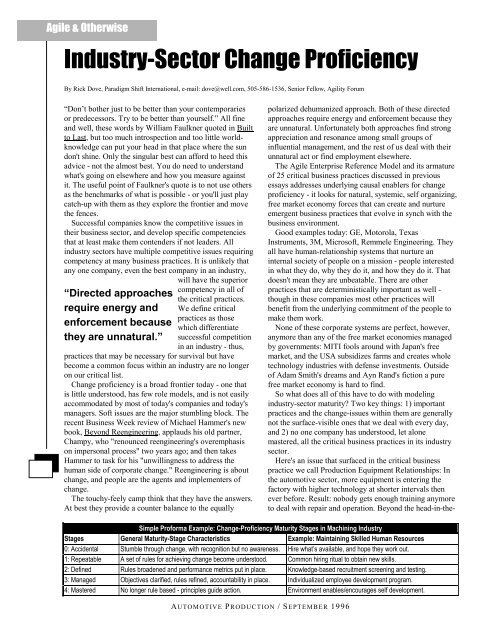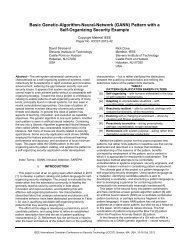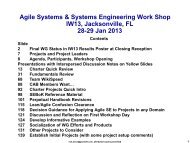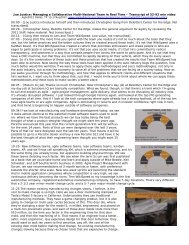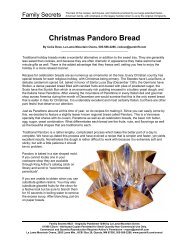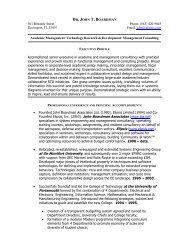23 - Paradigm Shift International
23 - Paradigm Shift International
23 - Paradigm Shift International
Create successful ePaper yourself
Turn your PDF publications into a flip-book with our unique Google optimized e-Paper software.
Agile & Otherwise<br />
Industry-Sector Change Proficiency<br />
By Rick Dove, <strong>Paradigm</strong> <strong>Shift</strong> <strong>International</strong>, e-mail: dove@well.com, 505-586-1536, Senior Fellow, Agility Forum<br />
“Don’t bother just to be better than your contemporaries<br />
or predecessors. Try to be better than yourself.” All fine<br />
and well, these words by William Faulkner quoted in Built<br />
to Last, but too much introspection and too little worldknowledge<br />
can put your head in that place where the sun<br />
don't shine. Only the singular best can afford to heed this<br />
advice - not the almost best. You do need to understand<br />
what's going on elsewhere and how you measure against<br />
it. The useful point of Faulkner's quote is to not use others<br />
as the benchmarks of what is possible - or you'll just play<br />
catch-up with them as they explore the frontier and move<br />
the fences.<br />
Successful companies know the competitive issues in<br />
their business sector, and develop specific competencies<br />
that at least make them contenders if not leaders. All<br />
industry sectors have multiple competitive issues requiring<br />
competency at many business practices. It is unlikely that<br />
any one company, even the best company in an industry,<br />
will have the superior<br />
“Directed approaches<br />
require energy and<br />
enforcement because<br />
they are unnatural.”<br />
competency in all of<br />
the critical practices.<br />
We define critical<br />
practices as those<br />
which differentiate<br />
successful competition<br />
in an industry - thus,<br />
practices that may be necessary for survival but have<br />
become a common focus within an industry are no longer<br />
on our critical list.<br />
Change proficiency is a broad frontier today - one that<br />
is little understood, has few role models, and is not easily<br />
accommodated by most of today's companies and today's<br />
managers. Soft issues are the major stumbling block. The<br />
recent Business Week review of Michael Hammer's new<br />
book, Beyond Reengineering, applauds his old partner,<br />
Champy, who "renounced reengineering's overemphasis<br />
on impersonal process" two years ago; and then takes<br />
Hammer to task for his "unwillingness to address the<br />
human side of corporate change." Reengineering is about<br />
change, and people are the agents and implementers of<br />
change.<br />
The touchy-feely camp think that they have the answers.<br />
At best they provide a counter balance to the equally<br />
polarized dehumanized approach. Both of these directed<br />
approaches require energy and enforcement because they<br />
are unnatural. Unfortunately both approaches find strong<br />
appreciation and resonance among small groups of<br />
influential management, and the rest of us deal with their<br />
unnatural act or find employment elsewhere.<br />
The Agile Enterprise Reference Model and its armature<br />
of 25 critical business practices discussed in previous<br />
essays addresses underlying causal enablers for change<br />
proficiency - it looks for natural, systemic, self organizing,<br />
free market economy forces that can create and nurture<br />
emergent business practices that evolve in synch with the<br />
business environment.<br />
Good examples today: GE, Motorola, Texas<br />
Instruments, 3M, Microsoft, Remmele Engineering. They<br />
all have human-relationship systems that nurture an<br />
internal society of people on a mission - people interested<br />
in what they do, why they do it, and how they do it. That<br />
doesn't mean they are unbeatable. There are other<br />
practices that are deterministically important as well -<br />
though in these companies most other practices will<br />
benefit from the underlying commitment of the people to<br />
make them work.<br />
None of these corporate systems are perfect, however,<br />
anymore than any of the free market economies managed<br />
by governments: MITI fools around with Japan's free<br />
market, and the USA subsidizes farms and creates whole<br />
technology industries with defense investments. Outside<br />
of Adam Smith's dreams and Ayn Rand's fiction a pure<br />
free market economy is hard to find.<br />
So what does all of this have to do with modeling<br />
industry-sector maturity? Two key things: 1) important<br />
practices and the change-issues within them are generally<br />
not the surface-visible ones that we deal with every day,<br />
and 2) no one company has understood, let alone<br />
mastered, all the critical business practices in its industry<br />
sector.<br />
Here's an issue that surfaced in the critical business<br />
practice we call Production Equipment Relationships: In<br />
the automotive sector, more equipment is entering the<br />
factory with higher technology at shorter intervals then<br />
ever before. Result: nobody gets enough training anymore<br />
to deal with repair and operation. Beyond the head-in-the-<br />
Simple Proforma Example: Change-Proficiency Maturity Stages in Machining Industry<br />
Stages General Maturity-Stage Characteristics Example: Maintaining Skilled Human Resources<br />
0: Accidental Stumble through change, with recognition but no awareness. Hire what’s available, and hope they work out.<br />
1: Repeatable A set of rules for achieving change become understood. Common hiring ritual to obtain new skills.<br />
2: Defined Rules broadened and performance metrics put in place. Knowledge-based recruitment screening and testing.<br />
3: Managed Objectives clarified, rules refined, accountability in place. Individualized employee development program.<br />
4: Mastered No longer rule based - principles guide action. Environment enables/encourages self development.<br />
AUTOMOTIVE PRODUCTION / SEPTEMBER 1996
sand responses, we see the allocation of more training<br />
time, hiring smarter people, and even elimination of<br />
automation in favor of more people.<br />
How about dealing with the real problem: tell your<br />
equipment vendors that within five years you will not<br />
purchase any equipment unless it can be maintained with<br />
less than 15 minutes of training and operated with less<br />
than 5 minutes of training - then give them some examples<br />
of how this might be achieved - and tell them that each<br />
purchase hereafter will evaluate the training requirements<br />
as part of the selection process.<br />
Does your industry care about this issue now? For some<br />
the answer is "No". But if you're in autos you better look<br />
at these numbers very seriously - Japan has already<br />
backed away from automation because it can't keep its<br />
machines running, and US manufacturers are simply<br />
shirking their training requirements and screaming louder<br />
at equipment vendors for a situation they have created<br />
(buy low and pay for what you get forever).<br />
Why do you think those new plants don't come on<br />
stream on schedule? The equipment doesn't work and<br />
nobody knows why or how to fix it! Lots of cussing and<br />
spit and bailing wire later we see a de-rated plant that is<br />
proudly proclaimed as late but wonderful; and then we<br />
hear "We learned from the experience." Just exactly what<br />
is it we learned? We'll never use those vendors or that<br />
design again? We'll assign different people in a different<br />
approach to the next plant conversion? All pushing at<br />
pimples and symptoms - nobody's looking at the disease.<br />
Equipment should be self diagnosing and able to<br />
foresee problems before they occur - not because this is<br />
they way it ought to be in some ideal world - but because<br />
this is the way some folks are actually already doing it. It<br />
can be done. Vendor experts should be able to place a<br />
phone call to the equipment and diagnose it with awesome<br />
expertise at hand. When anything other than module swap<br />
is required, a local untrained person should be guided<br />
through rare fix-it activity while online visually and<br />
audibly with vendor expertise and vast knowledge bases.<br />
But that's not the subject of this column.<br />
What are the key competitive change proficiency issues<br />
in your industry? They are not likely to be the same as the<br />
ones in another industry. How do you stack up against<br />
today's issues in your industry? If magic equipment<br />
maintenance or instant new-equipment mastery is not<br />
accomplished by anyone else in your industry, or if<br />
production equipment failure is not a significant factor in<br />
costs and productivity, then don't worry about it. But if<br />
either of these is true and you are not actively embarked<br />
upon a path toward graduate wizardry, then we're back to<br />
where the sun don't shine.<br />
The industry sector modeling projects (call us for<br />
participation) starting this fall and next year will:<br />
1) Identify sector-critical business practices.<br />
2) Identify key change issues in each practice.<br />
3) Identify defining capabilities of maturity stages.<br />
4) Build a comprehensive Change Proficiency Maturity<br />
Model for the 10-or-so critical business practices of<br />
current focus in the industry sector.<br />
Each sector project will have a modeling team of<br />
qualified participants from 5-7 companies in an industry -<br />
to provide breadth without becoming unwieldy. With<br />
group-ware tools and a structured analysis approach, one<br />
week in full-team workshop can knock off item 1 and<br />
scope out item 2. Then individual one-week workshops at<br />
each of the participant's operating sites examines three to<br />
five high competency practices, and collectively knocks<br />
off item 2 while scoping out item 3. A final full-team oneweek<br />
workshop deals with the findings to knock off item 3<br />
and build a complete model of all practices. Sensitivity<br />
about proprietary capabilities is mitigated by using neutral<br />
facilitator-analysts to guide the individual participantspecific<br />
workshops - and to filter the data for the final fullteam<br />
workshop for form rather than content.<br />
So maybe in your sector the model will show that<br />
equipment up-time is a problem, but nobody is focused on<br />
it strategically as yet. This puts it in the category of future<br />
focus as opposed to current. And that means it is an<br />
opportunity for innovative leadership and immediate<br />
disproportionate advantage.<br />
Creation<br />
Augmentation<br />
Migration<br />
Modification<br />
Correction<br />
Variation<br />
Expansion<br />
Reconfiguration<br />
Simple Proforma Example: Key Human-Relationship Change-Issues in Machining Industry<br />
Proactive Change Proficiency Issues<br />
Obtaining top quality people; and creating a sense of team, ownership, and responsibility.<br />
Improving personnel skills.<br />
Workforce diversity; top management succession.<br />
Gaining new skills; guarding against insularity.<br />
Reactive Change Proficiency Issues<br />
Correcting mismatches between people and their tasks.<br />
Filling critical slots when a key employee is absent.<br />
Finding more high-quality machinists; handling surge requirements.<br />
Reassigning tasks and responsibilities to meet special needs.<br />
<strong>Paradigm</strong> <strong>Shift</strong> <strong>International</strong> is an enterprise research and guidance firm focused on Agile operations and competitiveness. Its current<br />
focus is on customized industry- and corporate-specific Change Proficiency Maturity Models. Inquire at 505-586-1536 for participation.


